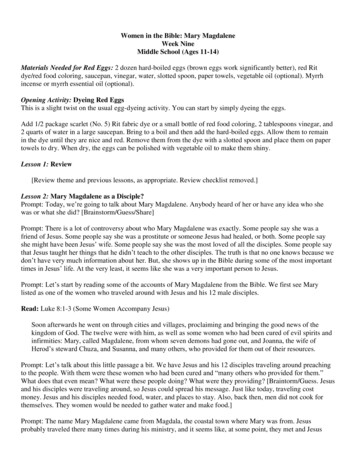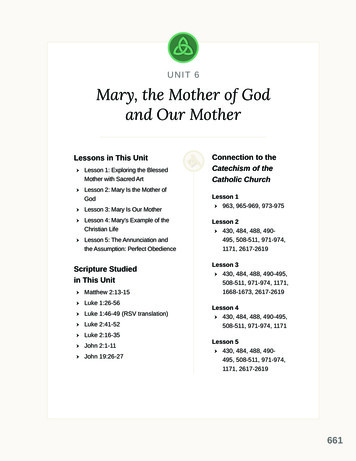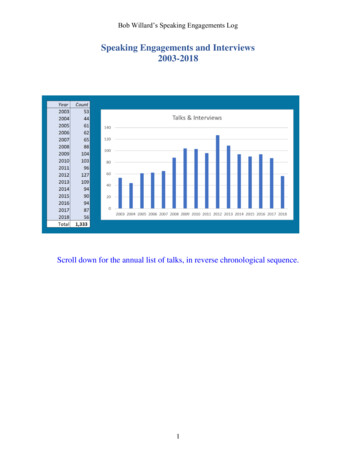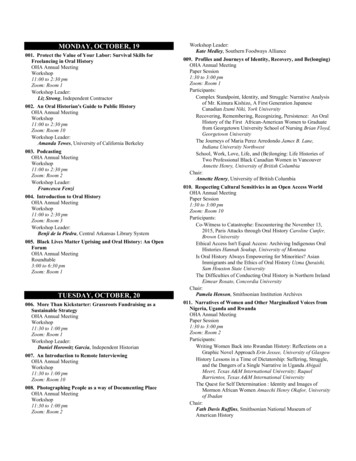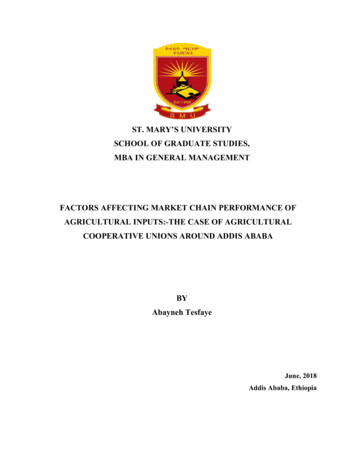
Transcription
ST. MARY’S UNIVERSITYSCHOOL OF GRADUATE STUDIES,MBA IN GENERAL MANAGEMENTFACTORS AFFECTING MARKET CHAIN PERFORMANCE OFAGRICULTURAL INPUTS:-THE CASE OF AGRICULTURALCOOPERATIVE UNIONS AROUND ADDIS ABABABYAbayneh TesfayeJune, 2018Addis Ababa, Ethiopia
FACTORS AFFECTING MARKET CHAIN PERFORMANCE OFAGRICULTURAL INPUTS:-THE CASE OF AGRICULTURALCOOPERATIVE UNIONS AROUND ADDIS ABABAA THESIS SUBMITTED TO ST. MARY’S UNIVERSITY SCHOOL OF GRADUATESTUDIES IN PARTIAL FULFILLMENT OF THE REQUIREMENTS FOR THEDEGREE OF MASTERS OF GENERAL BUSNESS ADMINSTRATIONBYAbayneh TesfayeID- SGS/0056/2009AJune, 2018Addis Ababa, Ethiopia
FACTORS AFFECTING MARKET CHAIN PERFORMANCE OFAGRICULTURAL INPUTS:-THE CASE OF AGRICULTURALCOOPERATIVE UNIONS AROUND ADDIS ABABAA THESIS SUBMITTED TO ST. MARY’S UNIVERSITY SCHOOL OF GRADUATESTUDIES IN PARTIAL FULFILLMENT OF THE REQUIREMENTS FOR THEDEGREE OF MASTERS OF GENERAL BUSNESS ADMINSTRATIONApproved by -BOARD OF EXAMINERDEAN, GRADUATE STUDIESADVISOREXTERNAL EXAMINERINTERNAL teDateDate
DeclarationI, the undersigned, declare that this Master research thesis entitled Factors Affecting marketchain performance of Agricultural input: the case of agricultural cooperative unions aroundAddis Ababa is submitted in partial fulfillment of the requirements for the degree of Masters ofGeneral Business Administration at St. Mary’s University. This thesis is my original work,prepared under the guidance of Mohammed M ( Ass. Prof), contains no material that has beensubmitted previously, in whole or in part, for the award of any other academic degree ordiploma.Abayneh Tesfaye.St. Mary’s University, Addis AbabaSignature and Datei
ENDORSMENTI , hereby certify that I have read and evaluated this thesis entitled factors affecting market chainPerformance of Agricultural input: the case of agricultural cooperative unions around AddisAbaba Area by Abayneh Tesfaye, under my guidance, I recommended it to be submitted asfulfilling his thesis requirementMohammed M (Ass. Prof.)St. Mary’s University, Addis AbabaSignature and Dateii
Table of ContentsDeclaration .iEndorsment . .iiTable of Contents . . .iiiAcknowledgement . .viAcronyms . .viiList of Table . .viiiList of Tables and Diagrams .ixAbstract .xCHAPTER ONE -INTRODUCTION . 11.1-Background of the Study . 11.2-Statement of the Problem . 31.4. Objective of the Study . 41.4.1. General Objective of the Study . 41.4.2. Specific Objective of the Study . 41.5. Significance of the Study . 51.6. Limitations of the study. 51.7. Delimitation of the Study . 51.8. Organization of the Study . 61.9. Definition of Key Terms . 6CHAPTER TWO -LITERATURE REVIEW . 72.1- Theories of Agricultural input market chain . 72.1.1- Concepts of Agricultural Input . 72.1.2. Concepts of Market chain . 82.2. Agricultural Input Marketing Chain in Ethiopia . 82.3. Factors Affecting Agricultural Input Market Chain performance . 9iii
2.4.1. Legal Factors . 102.4.2. Marketing Factor . 112.4.3. Financial Factor. 122.4.4. Service Delivery Factor . 132.5. Empirical Review . 142.7- Hypothesis of the Study . 19CHAPTER THREE -RESEARCH METHODOLOGY . 203.1 Study Area . 203.2. Research Design . 203.3. Research Approach . 203.4. Types and Sources of Data . 213.5 Study Population and Sample Size Determination . 213.5.1- Study Population. 213.5.2- Sample Size Determination . 213.6. Sampling Technique . 223.7. Methods of Data collection . 233.8. Validity and Reliability . 233.8.1- validity Test . 233.8.2-Reliability . 233.9. Method of Data Analysis. 243.10. Ethical Consideration . 25CHAPTER FOUR -RESULT AND DISCUSSION . 264.1 -Introduction . 264.1.1-Response Rate. 264.2-Descriptive statistics . 264.3-correlation Analysis . 334.4.1- Test of Regression Assumption . 33iv
4.4- Regression Analysis . 334.5- Hypothesis Testing. 41CHAPTER FIVE - SUMMARY, CONCLUSION AND RECOMMENDATIONS . 425.1 Summary . 425.2 -Conclusion . 435.3- Recommendations . 43APPENDIX I . liiAPPENDIX II . lviAPPENDIX III . lviiAPPENDIX IV . lviiiv
ACKNOWLEDGEMENTSFirst and Foremost, I glorify the Almighty God for giving me the strength, courage, wisdom andinspiration throughout the period of my studies.I express my sincere gratitude to my advisor Mohammed M(Ass.Prof.) for his support, patienceand motivation. His guidance helped me in all the time of research and writing of this thesis.I would like to take the opportunity to acknowledge Mr. Mesfin Endezinaw, Managing Directorof MEKAMBA PLC for his positive motives to start this course. It is my sincere to gratitudefor all who have supported me in this study and involved in the data collection. I am indebted tothose who agreed to participate in this research by completing the questionnaire, conducting thesurvey.vi
ACRONYMSACE- Agricultural cooperatives in EthiopiaAISE- Agricultural input supply EnterpriseADIL- Agricultural Development Led IndustrializationERS- Economic Resource ServiceEAL- Ethiopian Amalgamated LimitedDBE- Development Bank of EthiopiaICA- International Cooperative AllianceMOARD- Ministry of Agriculture and Rural DevelopmentNEPAD- New Partnership for African DevelopmentCAAD- Comprehensive African Agricultural DevelopmentMOA- Ministry of AgricultureNAIA- National Agricultural Input Supply AgencyNSIA- National Seed Industry AgencyNFIA- National Fertilizer industry AgencySSA- Sub Saharan AfricaMFIS- Micro Finance InstitutionMLR- Multiple linear regressionNEP- New Extensive programGM-Genetically ModifiedRTI- Royal Tropical InstituteSNV- Netherland Development organizationUSAD- United States Developments of Agriculturevii
List of TablesTable 3.1- sample proportion .24Table 3.2- Reliability test 26Table 4.1 - Distribution of Demographic characteristics .25Table 4.2- Distribution of socio economic characteristics . . .27Table 4.3- Mean Result 28Table 4.4- Correlations analysis. .29Table 4.5 -Regression analysis . . 30Table 4.6 – Regression Analysis model summery .31Table 4.7- ANOVA Result. 33Table 4. 8 - Multicollinearity Test .33Table 4.9- Auto correlation .34Table 4.10- Regression analysis of Coefficient . 34Table 4.11- Summary of Hypothesis Result . .36viii
List of Figures and DiagramsFig 2.1- conceptual framework .19Figure 4.1- Normal P-P plot 32Diagram 4-1- Histogram- Normality 33ix
ABSTRACTMarket chain of Agricultural input is an approach that allows cooperative unions to respond tomarket competition challenges on input supply. Agricultural cooperatives are ideal means forAgricultural input marketing for small holder farmers. Therefore; the major concern of thisthesis was to analyze factors affecting market chain performance of agricultural input and tomeasure the most determinant factors among the Legal, Marketing, service delivery andfinancial factors. The study uses explanatory research design with mixed approach of bothqualitative and quantitative data. Sampling techniques of the study were probability and nonprobability sampling. To select cooperative unions of the study area convenience samplingfrom none probability sampling techniques were used and random sampling were followedfrom probability sampling to select 200 respondents from the total of 400 population ofcooperative unions. Structured interview schedule and closed ended questionnaires were usedfor collecting the essential qualitative data and quantitative from the sampled respondents. Togenerate qualitative data structured interview were conducted. The quantitative data wereanalyzed using descriptive statistical tools, Pearson Correlation and Multiple LinearRegressions from inferential statistics. The major output of the study indicates that legal factorhave negative significant relationship with market chain while marketing, service delivery andfinancial factors have positive significant relationship with market chain Performance of thecooperative unions. In addition to this, the financial factor has the most determinant factoramong the variables. Therefore, it is recommended that, the legal factors which is mainlybureaucracy and regulation should be flexible and compatible with relevant actors of thecooperative unions along the market chain to bring about change for efficient and effectivedelivery of agricultural inputs/services. Likewise, financial factors are the most determinantfactor of market chain among independent variables.Key words:- market chain, Agricultural input, cooperative unions, legal factor, marketingfactor, financial factor, service delivery factor.x
CHAPTER ONEINTRODUCTION1.1-Background of the StudyAgricultural inputs are categorized into two types, consumable and capital input. Consumableinput includes fertilizers, seeds, pesticides, diesel oil electricity, etc, and on the other hand,capital inputs include tractors, trailers, harvesters, threshers, pump sets and other implements.There are some general aspects of the rural market like underdeveloped markets, illiteratebuyers, lack of communication facilities, many languages, vast spread of the market, storage,transport problems, seasonality and demand which are applicable to agricultural input marketsas well( Singh, 2012). However, agricultural input markets differ from other product markets inmany ways due to the nature of their products, the nature and location of users and the overallenvironment in which products are being bought and used. Agricultural inputs can beconsidered to be primarily yield saving or yield enhancing inputs. Their basic usefulness to thefarmer and therefore their potential comes fundamentally from the quantity of yield they areable to raise or saves which gives the agronomic potential. Grow agriculture, farm inputs needto be available, affordable, accessible, and good quality through legally established marketchain. Seeds, fertilizers, and agro-chemicals, are essential for improving the productivity andincomes of smallholder farmers (Singh, 2004).One of the key elements of agricultural transformation towards more commercial agriculture isthat the market mechanism becomes more important for many aspects of the farming business;not just for selling farm products but also for obtaining proper inputs credit, equipment andtemporary labor, markets become the dominant coordination mechanism. Providing inputs likefertilizers, agrochemicals and seeds has traditionally been one of the main economic functionsof agricultural sector. These sectors facilitate input access for farmers through bulk purchase,which lowers prices, or affiliation with larger group members (Pallant, 2001).Agricultural input Market chain is used to describe the numerous links that connect all theactors and transactions involved in the movement of agricultural inputs from the supplier/manufacturer to the final user( Farmer). Supporting these activities are services that enable thechain to operate efficiently. Agricultural inputs flow down the chain and money flows up thechain. The efficiency of the market chain is dependent upon how well information flows1
between chain actors, their level of business linkage, and the ability of services to overcomeproblems (Mark, 2007).In Ethiopia, the development of agricultural input markets has always been an important issuefor the agricultural sector and its stakeholders within existing agricultural input market chain.Price and quality developments in the input markets affect the comparative advantage ofagricultural production among regions and types of production; these developments also affectthe income of farm households and can have implications beyond the farm level. Concernsregarding the concentration in input markets have been expressed by different stakeholdergroups, including farmer unions, advocacy groups, and policy makers (Djurfeldt et al, 2006).In the recent past, there have been many experiments in the ago-input sector in terms ofnew distribution and marketing channels and some players have attempted to deliver totalsolutions to farmers including farm and allied inputs. These new channels range frommarketers own outlets to supermarkets to franchised outlets besides traditional mainstreamchannel of selling through distributors and dealers/retailers (Sukhpal, 2016).According to Dereje et al., (2016), use of modern agricultural inputs has been extremely limitedthat causes lower production. Grower’s continuous use of low yielding varieties will make itdifficult for the government to achieve maximum agricultural growth. Designing appropriateintervention programs to address the continuing challenges of limited use of improvedagricultural inputs requires an adequate understanding of the physical, technological, andcultural and socio- economic constraints associated with improved inputs use.Ethiopian Agricultural Development-led Industrialization (ADLI) development strategy adoptedby the country, which initially focused on food crops and natural resource management addedmarket orientation to this strategy. Reasonably priced, adequately, timely and sustainablesupplied agricultural inputs are necessary for the commercial transformation of Ethiopianagriculture. Major Improved Agricultural inputs such as seeds, agro chemicals, Fertilizers arefundamental part of the technology introduction services in agriculture sector. Most of theseinputs are supplied through the agricultural input importers. Government policy is stimulatingdiversification of input provision, involving private sector (Gebremedhin et al., 2006).A specialized market chain effort is required to reach the farmers who are spread acrossdifferent corners of the country. Observed facts on small holder farmers and report of thecooperative unions show there are large annual Agricultural input supply fluctuations.2
Therefore, the major concern of the paper is to identify major contributing factors for lowersupply of agricultural inputs along the market chain of cooperative union’s member smallholder farmers around Addis Ababa Area that will be an input for and existing input suppliersand regulatory Authorities.1.2-Statement of the ProblemAgricultural inputs are the basic requirements for agriculture to increase production andproductivity. Availability of these inputs is important for attaining production targets in thesector. Agricultural growth necessary for economic transformation comes from extended inputuse especially modern agricultural production enhancing inputs like fertilizer, pesticide andseeds that represent improved input technologies. According to Minot and Benson, (2009),Developing countries bring remarkable increase in agricultural productivity in a short period oftime through rapid uptake of yield increasing modern agricultural inputs.Most of Ethiopian small holder farmers have been using low agricultural inputs whichcontributed for low productivity Dereje et al., (2016). To solve these problems, governmentalorganizations have been motivated to bring about change in agricultural production system byputting a benchmark for the establishment of affordable, accessible and available agriculturalinput through the established market chain. Hence, a strong need to improve agriculturalproductivity and production through the adoption and adaptation of improved agriculturaltechnologies and techniques is critical by refining the existing agricultural input market chainAccording to Dawit (2005), some of the constraints of cooperatives of input marketing are: lowinstitutional capacity, inadequate qualified personnel, and lack of market information.Moreover, the prices of agricultural inputs are increasing where as availability of inputs isdeclining. These multiphase problems make difficult the overall activities of the cooperatives ininput marketing system which affects small holder farmers. These problems forces farmers asusually price takers due to the fact that they have poor marketing skill and limited bargainingpower. There have been attempts made by the government to improve the marketing skill andbargaining power of farmers through establishment of cooperatives and promoting other groupaction approaches.Agricultural cooperative federation is one of the actors that are responsible to supplyagricultural inputs to the cooperative unions according to the existing demands of small holderfarmers. However, according to five years of agricultural input distribution report of the3
federation, there is high supply fluctuation which shows the existing agricultural input marketchain could not satisfy the needs and demand of member farmers of the cooperatives. Thisindicated that there are different factors that are challenging these actors marketing system insupplying the inputs as per the requirement of cooperative unions and member farmers.Previous study conducted by Kassu (2009), analyzed agricultural input supply system and foundthat major factors influencing the Agricultural input supply systems are lack of availability ofagricultural inputs, Lack of flexibility of policy on registration process, lack of organized inputmarket and Absence of strong quarantine for imported products. Issues identified as a problemin the previous studied may not exist today or new changes and problem might have beenencountered in due course. Therefore, this study focused on Factors affecting market chain tomake agricultural input available for end users of the cooperative unions. It will also measurethe dependent variable called agricultural input market chain Performance using independentvariables developed from different literatures i.e legal, marketing, financial and service deliveryfactors, which is expected to attract other researchers to undertake further study in the area andimportant to be a background for regulatory improvement from government side, capacity andcapability improvement for market chain actors and stakeholders in general. Hence it attemptsto fill the existing gap of knowledge regarding the Agricultural input market chain systemamong cooperative unions.1.4. Objective of the Study1.4.1. General Objective of the StudyThe general objective of the study is to analyze factors that affect market chain Performance ofagricultural input around Addis Ababa Agricultural cooperative unions.1.4.2. Specific Objective of the Study1- To Analyze the effect of legal factor on agricultural input market chain Performance.2- To examine the effect of marketing factor on agricultural input market chain Performance3- To measure the effect of service delivery factor on agricultural input market chainPerformance4- To determine the effect of financial factor on agricultural input market chain Performance5- To identify the most determinant factors among independent variables.4
1.5. Significance of the StudyThe information generated from this study will be used in the formulation of appropriateregulation in the area of agricultural input marketing activities through government cooperativeand suppliers to promote input utilization in the development of smallholder’s agriculture.This study contributes to the identified farmer cooperatives to give full insight to overcome theexisting input availability constraints. It provide information on factors involved in the system,their linkage and knowledge flow in input market, the influential factors for the smoothfunctioning of the system and enabling policy formulation environment towards input marketchain system by giving special emphasis identified factors. The study also provides research,extension and development institutions with valuable information about market chainconstraints. Finally the study will be used a basis on which further research could be carried out.1.6. Limitations of the studyDuring Data Collection, due to the cooperatives federation company culture, Respondents wasnot expressed their feelings correctly what they think. In such cases, their practices andreferences were not assessed without limitation of bias. Some information’s which is relevantto the study were confidential to the federation that was limitation of the research. Lack ofsufficient availability of organized secondary data on the union and cooperative federation wasmajor problem. Bureaucratic issues in the cooperative unions to get secondary data wereanother limitation to this study.1.7. Delimitation of the StudyAgricultural input includes Seeds, Fertilizers, Pesticides, Farm Machinery and Equipment,Water/ Irrigation Structures, Animal Feeds, Veterinary Products and other fuels. But the scopeof this study delimited to the major consumable agricultural inputs i.e seeds, fertilizers and agrochemicals/ Pesticides because of its marketable volume and major effect on production andproductivity. The study was focused on small holders’ horticultural crop producers aroundAddis Ababa agricultural cooperative union. To conduct this study in all agricultural inputmarket chin actors, it was not a simple task that can be easily accomplished. Some of the actorsincluding privet importers and international supplier companies are excluded to narrow thescope due to time and budget constraints. In addition to this the study is delimited to fourindependent variables to measure the dependent variable: The independent variables that used inthis study to measure Market chain are Legal factor( bureaucracy and regulation) , marketing5
factor( product availability and accessibility), financial factor( credit and collateral)andservice delivery factor(service type and service quality).1.8. Organization of the StudyThis study is structured into five chapters. The first chapter introduces the background of theresearch along with statement of the problem, hypothesis, objectives, significance, limitationand delimitation of the study. Chapter two considers review of related literature; chapter threedescribed the methodology implemented; chapter four discussed result and findings; finally,chapter five covers the summary, conclusion and recommendation of the study.1.9. Definition of Key TermsAgricultural input-:- factors of production which enhancing and save production performanceAgricultural input Market chain:- is used to describe the numerous links that connect all theactors and transactions involved in the movement of agricultural inputs from the supplier/manufacturer to the final user( Farmer).Seed:- part of crop from which a new crop will grow( agronomic definition), botanically –fertilized ovuleFertilizer;- Any substance , which are added to the soil to supplement the soil with thoseelements required in the nutrition of plantsMarketing: - is the social process by which individuals and groups obtain what they need andwant through creating and exchanging products and value to each other’s.Product: - a product is anything that can be offered to a market for use or consumption thatsatisfies a want or need of consumers.Distribution: - it is the set of firms and individuals that take title or assist in transferring title to agood or service as it moves from the producer to the consumer.6
CHAPTER TWOLITERATURE REVIEW2.1- Theories of Agricultural input market chainAccording to Panda (2007), agricultural marketing is the study of all the activities, agencies andpolicies involved in the procurement of farm inputs by farmers and the movement of theagricultural products from the farms to the consumers. Therefore, in the broadest sense,agricultural marketing entails the aggregate socio-economic, which includes all the primaryactivities of production, interactions geared towards the utilization of natural resources forhuman welfare. Agricultural marketing is complicated by the diverse nature of the products tobe handled, and their perish ability. A further complication is the scattered nature of agriculturalproduction in most tropical countries like Ethiopia is very large number of separate productionunits. According to the International Cooperative Alliance (1995), cooperative is anautonomous association of persons united voluntarily
st. mary's university school of graduate studies, mba in general management factors affecting market chain performance of agricultural inputs:-the case of agricultural cooperative unions around addis ababa by abayneh tesfaye june, 2018 addis ababa, ethiopia .
